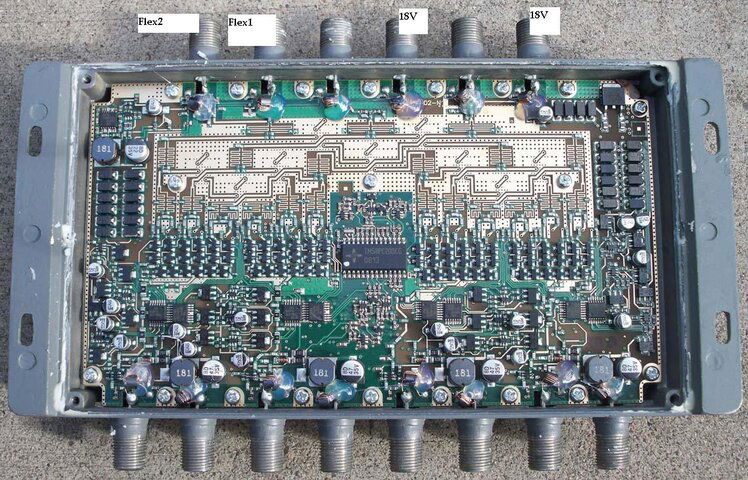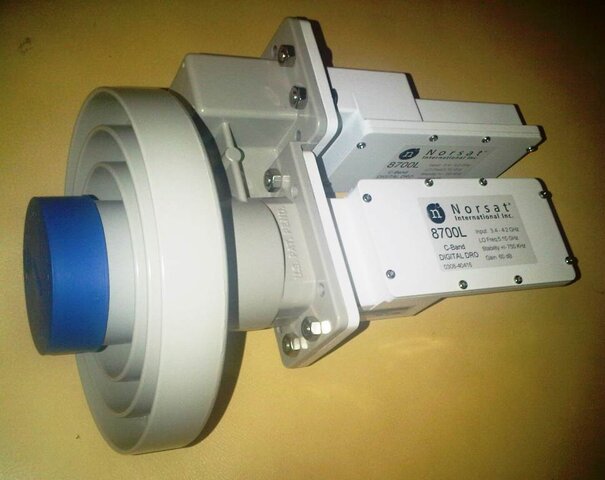Since WB68 switches are intended to work with low current LNBFs, these Flex ports may be always powered, hence no commands beyond regular 4x8 switch scope would be required if signal combining (with or without freq conversion - bandstacking) is involved. Such combining, if present, would probably produce the intended by Zinwell result only if the Flex port is connected to a proper freq (Ka?) DTV LNBF, hence it may not work correctly with a bandstacked Sadoun's LNBF. Even in that case it MAY be possible to separate (converted) signal at each OUT port of the WB68 switch using a modded diplexer or high freq splitter, with added Freq Converter to one leg of it if needed, and pass it via an unused port of an 8x1 switch to an FTA Receiver to use these extra Flex ports. Of course, some signal degradation may result from the extra gear, but in-line amps will presumably compensate this. Or, may be merely editing Channel List file freqs matrix will do. Of course its just all guessing without Zinwell docs.
No, it doesn't work this way. This is my understanding of the stacking plan for the four 'normal' ports of a Zinwell 6x8:
18V/no tone:
250-750: 99W Ka-lo RHCP
950-1450: 101W Ku RHCP
1650-2150: 99W Ka-hi RHCP
13V/no tone:
250-750: 99W Ka-lo LHCP
950-1450: 101W Ku LHCP
1650-2150: 99W Ka-hi LHCP
18V/22 kHz tone:
250-750: 103W Ka-lo RHCP
950-1450: 119W Ku RHCP
1650-2150: 103W Ka-hi RHCP
13V/22 kHz tone:
250-750: 103W Ka-lo LHCP
950-1450: 110/119W Ku LHCP
1650-2150: 103W Ka-hi LHCP
So the legacy Ku-band stuff is where it always was and the lower and upper spectrum extensions carry all of the Ka-band spectra. Flex ports 1 & 2 are only for 72.5W and 95W, which only use one polarization each to my knowledge. Thus the Flex ports may only be intended to pass 950-1450 MHz for DTV purposes, although Zinwell could have simplified the design by passing 250-2150 MHz on all six ports.
The Zinwell 6x8 only switches ports and does no up/downconversion to pick out individual bands. Power is only applied to an input port if that port is selected for use. Otherwise it would be quite a heavy load on a single receiver to power everything that could be connected to the input ports. The important point is some form of signaling is required to select the Flex ports, and this does not involve the other ports in any shape or form. It could be anything such as different voltages, tone bursts, DiSEqC commands, fill-in-the-blank. I'm sure it's nothing exotic, and divining it would likely only take a few minutes with a scope and a DTV setup. If you can get Zinwell or DTV to cough up the spec, that would be even better.
Regarding your concern that a DiSEqC switch may block these DTV Flex Port commands (if any), are regular DiSEqC 4x1 switches cascadable, i.e. can they pass full scope of DiSEqC commands? It sounds, they don't, only 8x1's can.
A DiSEqC switch should pass commands not intended for it, and for the most part this is what appears to happen with both 4x1 and 8x1 switches. Whether this has any effect on Flex ports remains to be seen. If DTV happened to be using DiSEqC switch commands for these ports, this could be a problem for more complex FTA switching applications.
I still wonder, if there is any measurable incoming signal on a WB68 Out port when 18V and 0/22 KHz is supplied to it, if only the switch's single Flex port is connected to a signal source - that would clarify if extra commands are used by a DTV STB to switch to a Flex port or power it up.
I think these points are rendered moot when considering DTV's stacking map. I have read many references to the special commands used for selecting Flex ports. That doesn't make them right, but in the absence of any evidence to the contrary this makes the most sense.



